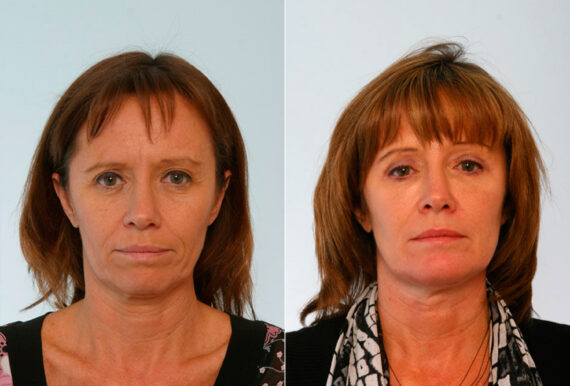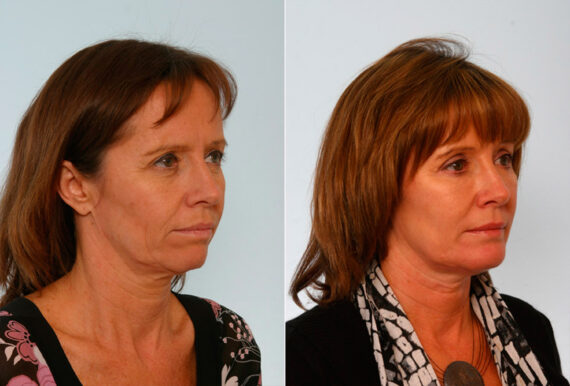A brow lift is a cosmetic procedure to raise the eyebrows and improve forehead wrinkles. Recovering from it involves several stages, each with specific healing benchmarks. From right after surgery to the ensuing months, patients experience gradual progress.
Dr. Paul Vitenas shares his knowledge on the recovery time stages, assisting patients in anticipating the healing process and Improving their results. This information is essential for those considering a brow lift, as knowing the recovery steps can make the experience more manageable and lead to satisfying results.

Recovering from a Brow Lift Step-by-Step
- Patients typically experience initial brow lift recovery within 10 to 14 days post-surgery, during which major swelling and bruising subside.
- It can take up to 6 months for the full effects of a brow lift to become apparent as the healing process continues.
- Minimizing activities that raise blood pressure helps reduce swelling in the first weeks after a brow lift.
- Following post-operative care instructions, such as keeping the head elevated, is essential for a smooth brow lift recovery.
- Return to normal activity after a brow lift varies, with most people resuming work within 2 weeks, but strenuous activity is often postponed for at least 4 weeks.
The First 24 Hours Post-Procedure
Immediate Aftercare
In the first few hours after surgery, patients must closely follow their plastic surgeon’s post-operative care instructions. Prescription pain medication is often given to manage discomfort. Comfort is important as it fosters a better environment for healing. Staying active with gentle movements is beneficial, but rest should be the priority.
Identifying Normal Responses and Potential Issues
After a brow lift, expect some swelling and bruising—these are normal symptoms showing your body’s repair process. A bit of blood or fluid at the incision areas soon after the procedure is usual. But, it’s crucial to watch for problems like excessive bleeding, sharp pain that isn’t helped by prescription pain medication, or strange discharge. If these occur, contact your care team right away. Noticing and reacting to these signs promptly can safeguard your recovery timeline.
Please contact your plastic surgery team immediately for these issues:
- Prescription pain medication not controlling severe pain
- Continuous bleeding or saturated bandages
- Indications of infection: increased redness, warmth, or odd discharge at the surgery site
Choosing this surgical procedure requires a commitment to adhering to the recovery timeline and distinguishing normal symptoms from complications, which can greatly affect the result. While there are alternatives to brow lift, proper care after the procedure is essential.
The First Week of Recovery
Days 1-3: Managing Pain and Swelling
During the first three days after a brow lift, it’s important to manage discomfort. Using ice packs and cold compresses can effectively reduce swelling. Pain relief is also managed with prescribed pain medication, which should be taken as instructed to minimize discomfort. It’s advised to rest and keep the head elevated to help with swelling. By the end of this period, you generally notice a reduction in both pain and swelling.
Days 4-7: Assessing Healing and Suture Removal

Towards the end of the week after surgery, you’ll visit the plastic surgeon for follow-up appointments. These check-ins allow the surgeon to monitor the healing process and decide if a surgical revision is unnecessary. Suture removal is an important step that takes place during these appointments and indicates progress in the recovery process.
Adhering to the advice given during these sessions and caring for yourself in this initial week is essential for effective brow lift recovery.
- Use ice packs and cold compresses for swelling.
- Take prescribed pain medication for pain.
- Rest and elevate the head to further reduce swelling.
Attend all follow-up appointments to:
- Ensure proper healing.
- Have sutures removed, marking progress.
- Determine if surgical revision is unnecessary.
Remember, the actions taken during this first week are crucial for the overall recovery process after a brow lift.
Weeks 2 and 3 Post-Surgery
Reduced Swelling and Bruising
Most patients experience decreased swelling and bruising within 2-3 weeks of the procedure, a positive sign of recovery. It’s vital to follow the aftercare instructions provided by your plastic surgery practice. Applying ice packs regularly can help minimize swelling and promote steady healing.
Easing Back Into Daily Life
By weeks 2 and 3, slowly reintegrating into normal activities is often safe, as the body adjusts after a brow lift, whether it’s a thread brow lift or an endoscopic lift. Light activities are typically manageable, helping to regain a sense of routine.
Patients should note the ongoing activity restrictions:
- Activity Restrictions: Heavy lifting and intense physical activity are advised against during this time to preserve the healing process.
- Type of Brow Lift: The specific type of brow lift, a thread brow lift or an endoscopic lift, may influence your timeline for resuming activities.
- Routine: Gradually take up tasks that are not strenuous to the healing area.
It’s essential for safety and optimal results to respect these guidelines as part of the recovery process.
One Month After Surgery
A month into the brow lift recovery, patients typically notice the following improvements:
- Healing: Reduced redness and swelling suggest effective progress.
- Incision Lines: These become less noticeable, aiding in achieving a youthful and balanced appearance.
- Appearance: The brows settle in a more natural position, enhancing the face’s overall look.
- Prescribed Pain Medication: Less reliance on these medications as discomfort decreases.

It’s important to keep following your surgeon’s advice on skin care to support the healing time and ensure desirable outcomes. Continue to monitor the signs over the weeks, as they are indicative of a successful forehead lift.
2-3 Months Post-Procedure
Observing the Settling of Results
By the 2-3 months post-procedure point, patients who have had an Endoscopic Brow Lift typically notice their facial appearance stabilizing. This period marks a visible change as the brow lift effects fully emerge, showing a more youthful appearance. The defined contours from a brow or forehead lift are generally more noticeable now.
Patients are usually able to resume all their usual activities, such as exercises and strenuous activities, which they could not do right after surgery. Follow-up appointments are crucial to monitor healing.
The complete brow lift results should be evident at this time, allowing individuals to see the benefits of the lift. Both the appearance and functionality come together as patients return to their daily routines, making it an important phase in the recovery process.
6 Months and Beyond
Sustaining Your Results
A brow lift’s impact extends past initial recovery. Ongoing attention to long-term care is vital for ensuring the durability of your results. Different techniques, including the classic lift, thread brow lift, and temporal brow lift, all require continuous care for optimal final outcomes.
Effective long-term care typically involves:
- Applying sunscreen regularly to shield the skin from UV rays.
- Adhering to a skincare routine that complements your brow lift.
- Attending follow-up visits at your plastic surgery practice to check on the progress and upkeep of your results.
While a major plastic surgery like a brow lift doesn’t stop aging, proper care can prolong the fresh, lifted look. The sustained position of the brow, maintained tissue health, and skin quality are visible signs of diligent care.
Ongoing care post-surgery not only maintains the look but also adds to the lasting youthful appearance a brow lift affords. Your dedication to post-operative care reinforces the enduring benefits of your facial plastic surgery.
If you’re considering a brow lift and want to ensure a smooth recovery, getting expert advice is important. Dr. Paul Vitenas, with decades of plastic surgery experience, offers personalized care to guide you through the process. His practice has been recognized for outstanding patient satisfaction and results, reflecting his commitment to excellence in aesthetic surgery.
To learn more about your recovery and the specific steps you’ll take after a brow lift, schedule a consultation with Dr. Vitenas. As a top plastic surgeon in Houston, he’ll provide you with a detailed plan tailored to your needs, helping you understand what to expect at every stage of recovery. Contact our office today to take the first step toward your aesthetic goals.


